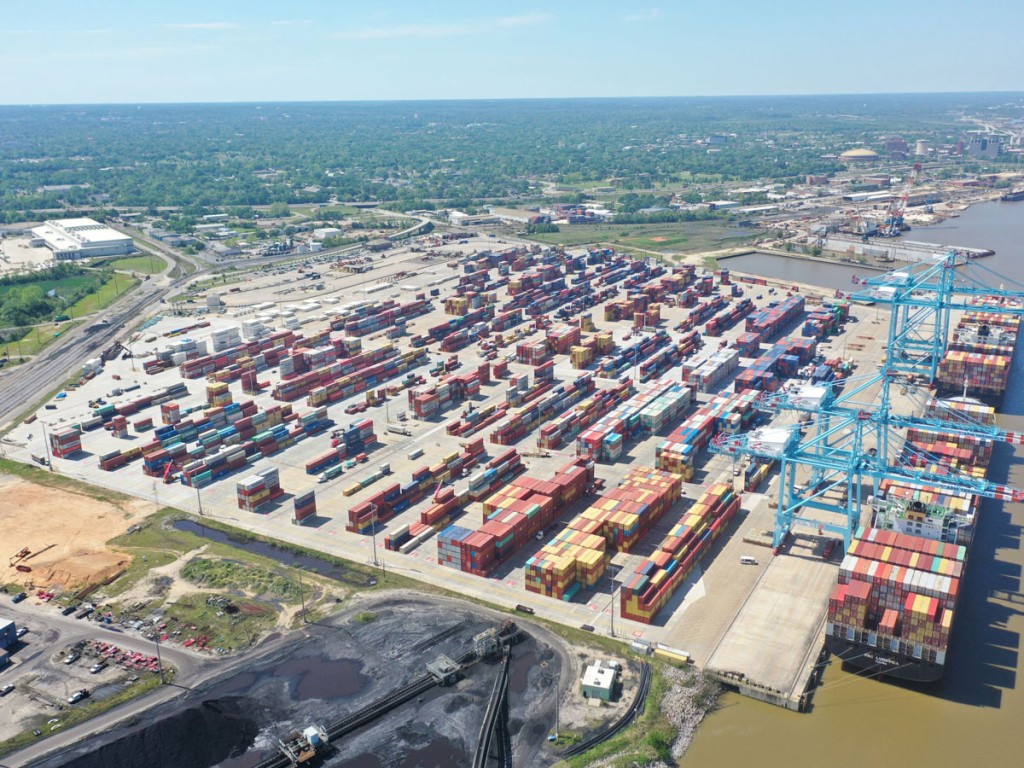Strong port operations combined with landside logistics attracts more customers, higher import/export volumes, more port calls, larger ships, more logistics hubs.
APM Terminals Mobile has signed an agreement with the Alabama State Port Authority to add 32 acres to the current 134 acre container terminal yard to keep pace with future demand, creating one million TEU throughput capacity that is approved to handle 14,000 TEU ships. This represents the third expansion in the last six years as importers expand their volumes to meet regional consumer demand and tap into rail service to the Midwest U.S. market.

APM Terminals Mobile now ranks as the second largest U.S. Gulf port for container imports. April 2022 container volumes through the port showed a 39.7% increase over April 2021 volumes. The port’s intermodal container transfer facility posted 112.6% growth during the same period. Refrigerated cargo also maintained its double-digit growth, posting a 57.9% gain over the same period.
APM Terminals Mobile’s operational performance and inland access is driving the growth in services:
Port: Port productivity of 35 crane moves per hour berth productivity.
Ocean: Five weekly services from Asia, one North Europe service, one Intra-Americas service.
Rail: Daily rail departures to U.S. Midwest markets via Five Class I railroads serving the port (2.5 day direct doublestack service to Chicago). Two new cranes were added to the near dock, Intermodal Container Transfer Facility (ICTF) in August 2021. In 2024, more rail infrastructure will be added in Montgomery, Alabama when the Alabama Port Authority and CSX build an intermodal container transfer facility to serve expanding port volumes.
Truck: High productivity truck gates. 52 minute turntimes, including 83% dual transactions (where truckers optimize their route, bringing in export containers or empty containers and picking up a full import container).
Logistics: Five major logistics parks nearby.
Air freight: Mobile Aeroplex at Brookley is adjacent to port for ecommerce/parcel/aerospace.
Cold chain: CN refrigerated packs available for northbound rail cargoes. New cold storage facility opened October 2021.
“Supply chain leaders are looking to expand their routing options in 2022 to add more flexibility and fulfillment speed to serve consumer demand. We’re working with customers to deliver high port productivity, more port space and more inland logistics connectivity to address the market demand,” said Brian Harold, Managing Director of APM Terminals Mobile.
New Central America service added
Sealand – A Maersk Company has added a new service called the Bonita Express with the inaugural call at APM Terminals Mobile on May 18th. The new, direct all-water service links Mobile in the U.S. Gulf to the key Central American ports of Puerto Cortes in Honduras and Santo Tomas de Castilla in Guatemala (with connectivity to multiple inland locations including to/from Nicaragua and El Salvador).
Alabama as a site selection
Major companies already in Alabama are Hyundai, AM/NS Calvert, Outokumpu, Northrop Grumman, Mercedes Benz, Honda, Airbus, Amazon, Walmart, BendPak and Bella + Canvas have selected the Port of Mobile and the state of Alabama as a hub for global logistics supply and distribution as well as manufacturing.
Alabama business incentives and customs tax packages are designed to attract new and expand existing industries. A variety of jobs and investment credits are available for qualifying projects. Other business incentives include tax credits for cargo owners on incremental cargo volumes.










